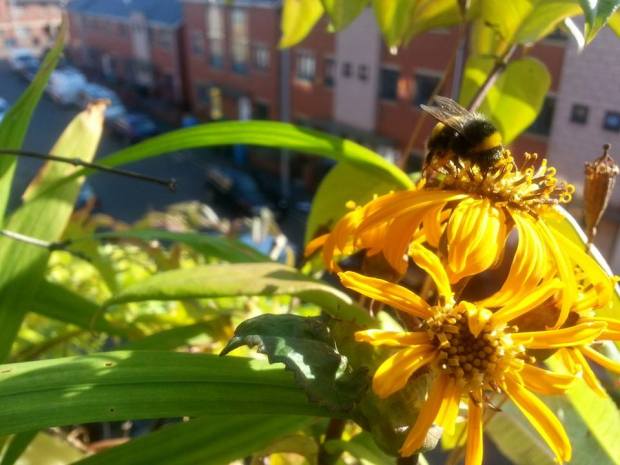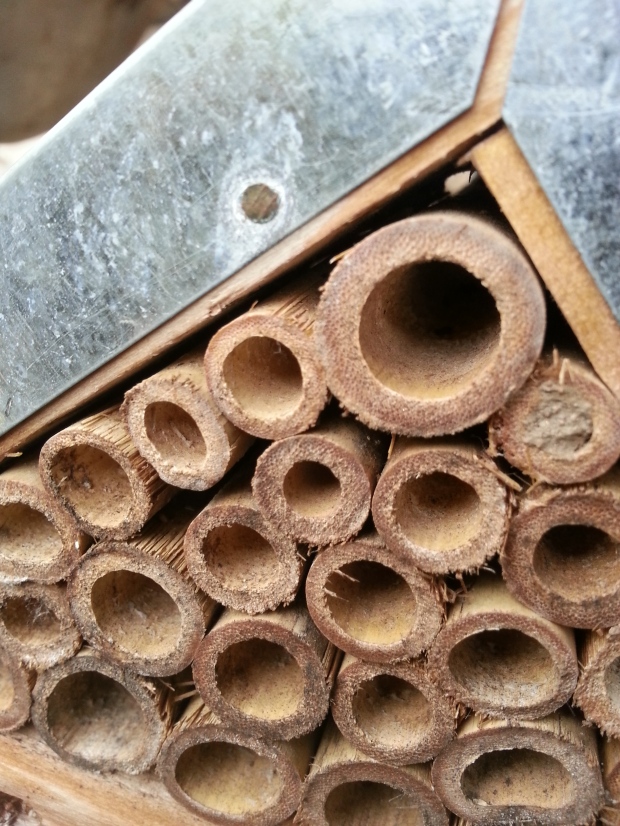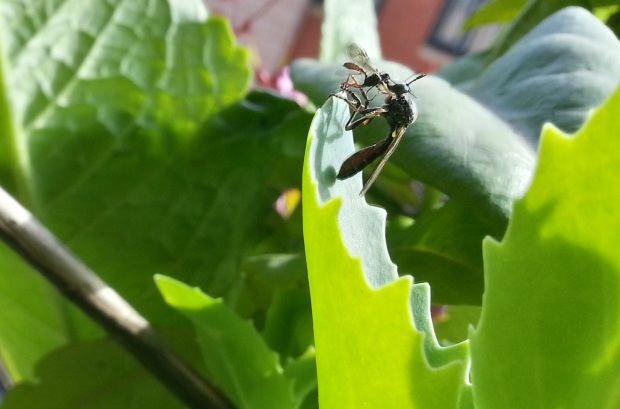2014 – The year in focus
Whilst 2013 had been a relatively warm and sunny year for the “Wildlife Garden Balcony” , 2014 could best be described as more of a “mixed bag” – meteorologicaly speaking. Nevertheless , the balcony continued to attract and sustain a wide variety of wildlife. Here are few photographic highlights taken over the year :
 The warm summer months were great for pollinating insects with Bumble bees (as seen above) and Hoverflies (seen below) making great use of the abundant nectar provided by this ligularia dentata which I had freshly acquired and planted on to the balcony that year
The warm summer months were great for pollinating insects with Bumble bees (as seen above) and Hoverflies (seen below) making great use of the abundant nectar provided by this ligularia dentata which I had freshly acquired and planted on to the balcony that year
 I’d also introduced this beautiful Purple Angelica for the first time to the balcony this year and was equally impressed by it’s ability to attract pollinating insects as I was by its magnificent crimson flowers. It’s glistening, nectar rich florets became a magnet for Bees, Hoverflies and, as can be seen in the photo, Common Wasps. Whilst Wasps are, understandably, unpopular with many people, they actually serve a very important role in the ecosystem: they are great pollinators and also feed on caterpillars, aphids and other common garden “pests”
I’d also introduced this beautiful Purple Angelica for the first time to the balcony this year and was equally impressed by it’s ability to attract pollinating insects as I was by its magnificent crimson flowers. It’s glistening, nectar rich florets became a magnet for Bees, Hoverflies and, as can be seen in the photo, Common Wasps. Whilst Wasps are, understandably, unpopular with many people, they actually serve a very important role in the ecosystem: they are great pollinators and also feed on caterpillars, aphids and other common garden “pests”
 My Dustbin Lid Meadow continued to evolve and change with Red Clover dominating the mini meadow over 2014’s summer months. The Clover helps to fertilise the meadow naturally, providing nitrogen to the soil through its roots. The flowers are also a fantastic source of nectar for pollinating insects , such as this Small Skipper Butterfly which can be seen just centre right in the photo
My Dustbin Lid Meadow continued to evolve and change with Red Clover dominating the mini meadow over 2014’s summer months. The Clover helps to fertilise the meadow naturally, providing nitrogen to the soil through its roots. The flowers are also a fantastic source of nectar for pollinating insects , such as this Small Skipper Butterfly which can be seen just centre right in the photo
 Harlequin Ladybird seen here next to the larval case it’s emerged from. They are an introduced species and one which has reeked havoc on our own, smaller native species ladybirds. I didn’t see as many of them on the balcony this year but nationally they are still spreading rapidly and threatening to wipe out are native species ladybirds.
Harlequin Ladybird seen here next to the larval case it’s emerged from. They are an introduced species and one which has reeked havoc on our own, smaller native species ladybirds. I didn’t see as many of them on the balcony this year but nationally they are still spreading rapidly and threatening to wipe out are native species ladybirds.  My newly acquired “Bug Hotel” quickly became a home for solitary wasps: If you look at the top right hand corner, you can see that a Inchuimid or potter wasp has sealed the opening with a plug of clay. It does this after capturing a caterpillar which it then deposits inside the cane and lays an egg on it. It then seals the opening with the clay and makes its departure. Once the egg eventually hatches, the emerging larvae has a “ready made” meal in the form of the poor caterpillar. “Insect Hotels” or “Bug Houses” are an excellent habitat for bees, ladybirds, hoverfiles and countless other insects which use them for nesting and for hibernation. Most garden centres sell them ready made or they can be bought online. Alternatively, it’s also very easy to build your own (using cut bamboo canes) and can be as simple or as elaborate as you wish. Here are a few great examples
My newly acquired “Bug Hotel” quickly became a home for solitary wasps: If you look at the top right hand corner, you can see that a Inchuimid or potter wasp has sealed the opening with a plug of clay. It does this after capturing a caterpillar which it then deposits inside the cane and lays an egg on it. It then seals the opening with the clay and makes its departure. Once the egg eventually hatches, the emerging larvae has a “ready made” meal in the form of the poor caterpillar. “Insect Hotels” or “Bug Houses” are an excellent habitat for bees, ladybirds, hoverfiles and countless other insects which use them for nesting and for hibernation. Most garden centres sell them ready made or they can be bought online. Alternatively, it’s also very easy to build your own (using cut bamboo canes) and can be as simple or as elaborate as you wish. Here are a few great examples
 Robber Fly (aka the “assassin fly”) eating a parasitic wasp. This ruthlessly efficient predator hunts and eats a wide variety other insects. Wikipedia says of it:
Robber Fly (aka the “assassin fly”) eating a parasitic wasp. This ruthlessly efficient predator hunts and eats a wide variety other insects. Wikipedia says of it:
In general the family attacks a very wide range of prey, including other flies, beetles, butterflies and moths, various bees, ants, dragon and damselflies, ichneumon wasps, grasshoppers, and some spiders. They do so apparently irrespective of any repugnatorial chemicals the prey may have at its disposal.[5]
Many when attacked in turn do not hesitate to defend themselves with their proboscides and may deliver intensely painful bites if handled incautiously.
The antennae are short, 3-segmented, and sometimes bear a bristle-like structure called an arista. The fly attacks its prey by stabbing it with its short, strong proboscis injecting the victim with saliva containing neurotoxic and proteolytic enzymes which very rapidly paralyze the victim and soon digest the insides; the fly then sucks the liquefied material through the proboscis.
The life histories are poorly known. Larvae generally seem to live in soil, rotting wood, leaf mould and similar materials, some being predatory and others detrivorous.[5]
 This Sailor Beetle (a member of the soldier beetle family) was seen for the very first time on my balcony in 2014. Whilst the adults are often found feeding on the nectar from umbelliferous flowers (such fennel, yarrow, sweet cicely and angelica) their larvae are known to hunt out snails and slugs….making them another gardeners “best friend”
This Sailor Beetle (a member of the soldier beetle family) was seen for the very first time on my balcony in 2014. Whilst the adults are often found feeding on the nectar from umbelliferous flowers (such fennel, yarrow, sweet cicely and angelica) their larvae are known to hunt out snails and slugs….making them another gardeners “best friend”
 I was also delighted to see , and for the very first time on the balcony, this exotic looking Ruby Tailed Wasp. It was found lurking around the “bug hotel” , undoubtedly waiting to lay its eggs in the cell of some unsuspecting solitary bee or wasp which had taken up residence in the “bug hotel”. The Wildlife Trusts Website explains;
I was also delighted to see , and for the very first time on the balcony, this exotic looking Ruby Tailed Wasp. It was found lurking around the “bug hotel” , undoubtedly waiting to lay its eggs in the cell of some unsuspecting solitary bee or wasp which had taken up residence in the “bug hotel”. The Wildlife Trusts Website explains;
The glittering, metallic Ruby-tailed Wasp is one of many species of solitary bee and wasp that can be spotted in a number of habitats from walls to sandy quarries, rocky outcrops to tree trunks. These insects do not live in colonies like Honey Bees; instead the female builds a nest by herself, stocks it with pollen and lays an egg within each cell she has created. However, the adults of the Ruby-tailed Wasp are a little lazier: the females actually lay their eggs in the nests of other solitary bees and wasps, especially Mason Bees. When the eggs hatch, they eat the larvae of the Mason Bees and develop – this gives the Ruby-tailed Wasp its other name of ‘Cuckoo Wasp’
 This Great Pied Hoverfly (volucella pellucens) flew in from the balcony one evening and landed on my lampshade, apparently attracted by the light. Like all hoverflys, they are completely harmless to us and only mimic the appearance of bees and wasps in order to deter predators from eating them
This Great Pied Hoverfly (volucella pellucens) flew in from the balcony one evening and landed on my lampshade, apparently attracted by the light. Like all hoverflys, they are completely harmless to us and only mimic the appearance of bees and wasps in order to deter predators from eating them
 This delightful Small Skipper Butterfly , spotted for the first time on my balcony, can be seen sipping nectar from the equally colourful Purple Toadflax. Although the Toadflax is somewhat invasive it really “earns its keep” on the balcony with its very long flowering period and copious supplies of nectar for bees and butterflies alike.
This delightful Small Skipper Butterfly , spotted for the first time on my balcony, can be seen sipping nectar from the equally colourful Purple Toadflax. Although the Toadflax is somewhat invasive it really “earns its keep” on the balcony with its very long flowering period and copious supplies of nectar for bees and butterflies alike.
 Of course, it wasn’t just insects which benefited from the Wildlife Garden Balcony in 2014. Blue Tits, Coal Tits and , as seen above, Great Tits were regular visitors to my home made birdfeeder and whose images were captured on my Birdcam. Unfortunately, as you can see from the above photo, the Birdcam camera seems to have developed a fault with the date and time display and which has proven impossible to fix – unless of course, it really is 2019? So, if the nice folks at Wingscapes (who make the Birdcam ) want to exploit the excellent promotional opportunities afforded by my blog site, then please feel free to send me a replacement Birdcam. And yes, this really is a shameless blag for a freebie 😉
Of course, it wasn’t just insects which benefited from the Wildlife Garden Balcony in 2014. Blue Tits, Coal Tits and , as seen above, Great Tits were regular visitors to my home made birdfeeder and whose images were captured on my Birdcam. Unfortunately, as you can see from the above photo, the Birdcam camera seems to have developed a fault with the date and time display and which has proven impossible to fix – unless of course, it really is 2019? So, if the nice folks at Wingscapes (who make the Birdcam ) want to exploit the excellent promotional opportunities afforded by my blog site, then please feel free to send me a replacement Birdcam. And yes, this really is a shameless blag for a freebie 😉
 In the early part of 2014, researchers wanting to film an episode about wildlife gardens for the BBC’s The Great British Garden Revival contacted me and asked if they could come and film my balcony! As the whole point of this blog is to encourage and inspire other people to create wildlife balcony gardens of their own, I obviously said YES!
In the early part of 2014, researchers wanting to film an episode about wildlife gardens for the BBC’s The Great British Garden Revival contacted me and asked if they could come and film my balcony! As the whole point of this blog is to encourage and inspire other people to create wildlife balcony gardens of their own, I obviously said YES!
So, in June a camera crew descended on my flat and filmed part of the episode which was eventually broadcast on BBC 2 on the 21st January – the following year. To see it, just follow the iplayer link HERE. The balcony makes an appearance 27 mins and 30 secs into the episode. Following the broadcast , I had lots of enthusiastic twitter mentions from people feeling really inspired to create their own mini-wildlife gardens as well as hundreds of hits on this blog site. What a great end to 2014 and a fantastic beginning to 2015 for the Wildlife Garden Balcony!

Lovely blog, but mesh bags should never be used to feed the birds. They can cause horrible injuries by legs or feet getting trapped in them, and any bird with a barbed tongue can be trapped by their beaks. You should always use proper feeders
LikeLiked by 1 person
Thanks for pointing that out. I’d never heard of mesh bags posing a threat to birds before but a quick look at the RSPB website reveals the following advice: ” Mesh bags – a warning
Peanuts and fat balls are regularly sold in nylon mesh bags. Never put out any food in mesh bags. These may trap birds’ feet and even cause broken or torn off feet and legs. Birds with a barbed tongue, eg woodpeckers, can become trapped by their beaks” Thanks again for flagging this up and would strongly encourage others in only using non-mesh bag feeders from now on.
LikeLike
Living in The Netherlands and seeing the episode of TGBGR on BBC, I was so inspired by you! The next morning I took Google to find you and have subscribed. I cannot wait to go and buy the plants for my balcony this year. For now it only has one climbing rose (Zephire Droughin), 3 little lavendar’s and that is it (lol). I bought however some birdfeeders and food yesterday, so this weekend I have a little project. My balcony is south faced, so lots of sunshine! However, i do live on the 5th floor so I wonder if birds and insects can find my adress 😉 Good luck with your wonderfull “garden” , you are doing a great job!.
LikeLiked by 1 person
Thanks Ellie. It’s great to hear that you feel so inspired by the BBC episode on my balcony. I think you’ll find that the birds and insects will have no problem finding your balcony if you create the right conditions for them; shelter, nectar rich flowers , bird food and even a birdbath. Have a look at my following page: https://valiantveggie.wordpress.com/about/what-to-do-2/ and then follow the other pages which lead on from it . They’ll tell you how I prepared suitable containers, compost and then chose the right plants to attract wildlife. Good luck with it and let me have some photos of the balcony when you’ve done it all 🙂
LikeLike
Birdfeeders are up and running ! I have spotted some very small birds already! Don’t know which ones yet. I have to get me a book on that 😉 Thanks for your advice.
LikeLiked by 1 person